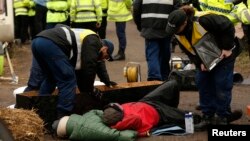The political crisis in Ukraine, including its dispute with Moscow over the flow of Russian natural gas, has forced many European nations to reconsider their reliance on Russia for energy. Some nations are looking at new options for extracting natural gas at home, including the controversial process of hydraulic fracking.
Although much of Europe is dependent on Russian energy imports, the continent is believed to be sitting on 13 trillion cubic meters of shale gas, a significant reserve.
France, Poland and Ukraine share the largest amounts of shale gas, but reserves have been found in Romania, Bulgaria and the United Kingdom.
The presence of large shale gas reserves and the current crisis in Ukraine have sharpened the focus on Europe’s shale gas potential, according to Lucia Seybert, at the Wilson Center in Washington.
“With energy security it’s not just a matter of supply, it’s also a question of reliability. And one thing this thing may do, what might happen is, it may expedite some of these explorations of shale gas within the European Union,” Seybert said.
Still, Europe is believed to be years away from commercially exploiting shale gas. Poland, the United Kingdom and Romania are the farthest along - and expect to start exploration by 2020.
But extracting shale gas - using a technique called hydraulic fracking, is controversial. Most drilling sites in Europe are near populated areas and environmental groups have raised concerns about water and air pollution.
There also are political issues. European taxes on the industry and strict regulations create a challenge for extraction companies.
“It is much more complex extracting the gas in places like Poland and Central Europe than it is in the U.S. So we really need to better understand how much is there and how easily we can actually get it out of the ground,” said Eric Stewart, president of the Romanian-American and Polish-American Business Councils.
Energy companies also must battle a strong environmental movement and public opposition.
The process can help meet Europe’s energy needs if it complements conventional and renewable sources of energy like solar and wind, said
Keith Smith, a former U.S. ambassador to Lithuania, now a fellow at the Center for European Policy Analysis and an expert on fracking technology.
“I think hydraulic fracturing is one element that can help bring energy security to Europe, but it will take a long time. I think it can happen but it’s only one factor. There are a lot of other things that need to be done," he said.
Much of Europe’s gas flows through a pipeline that runs from Russia across Ukraine. But Ukraine has had trouble paying its gas bill to Russia’s Gazprom energy company. And earlier this year, Ukrainian protesters ousted the country’s pro-Russia president. The new government has signed economic agreements with the European Union, over Moscow’s objections. Moscow has signaled it may cut off gas to Kyiv, and thus to much of Europe.
With winter approaching, the current dispute looks similar to the crisis in 2009, when Russia stopped the natural gas flow to Europe in January, leaving millions of homes and businesses in the cold.
"The European Union has got burned - or, frozen, I should say - with the 2009 crisis so they really worked hard to prevent something like that from reccurring, and there has been much talk about the interconnection of pipelines, alternative sources and reverse flow mechanism, so we will see,” Seybert said.
Shale gas exploration will not achieve complete energy independence from Russian imports, but will lessen that dependence long-term.
That would be beneficial for both Europe and Russia, a country that needs a more diversified economy and less dependence on energy exports, she said.







